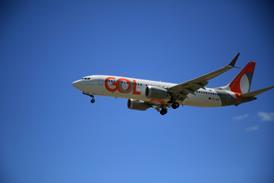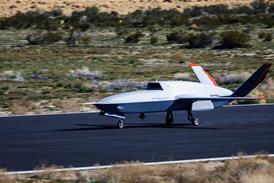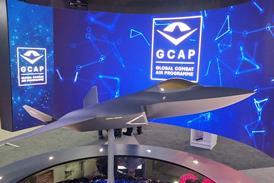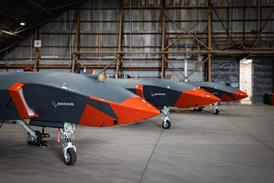The final test example of Boeing’s new T-7A Red Hawk trainer jet has completed its first flight with a US Air Force (USAF) pilot.
Test pilot Lieutenant Colonel Shay Brantigan took the controls of the fifth T-7A jet assembled by Boeing for a customer acceptance flight on 12 December at Boeing’s fighter delivery centre at St. Louis Lambert International airport in the central USA. The jet, tail number APT-5, represents the final test aircraft to be delivered under the engineering and manufacturing development phase of the T-7A programme.
“It’s our fifth and last test jet,” Brantigan says, in a video of the APT-5 acceptance flight released by Boeing.
“We’re focused on making sure that all of the displays in the aircraft, that the performance of the aircraft is what the customer expects,” he adds.
Brantigan serves as commander of the USAF’s 416th Test Squadron at Edwards AFB in California, which is overseeing the service’s T-7A test and evaluation programme.
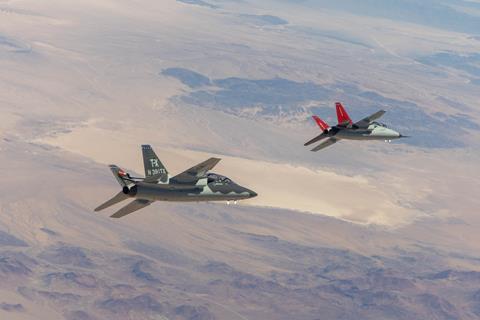
Following his flight with APT-5, which included an afterburner take-off, Brantigan praised the jet’s handling qualities, describing them as “great”.
The USAF plans to acquire up to 350 Red Hawks to replace the service’s aged fleet of Northrop T-38 Talon trainers, which are now plagued by maintenance issues after 60 years in service. The 2018 trainer replacement contract with Boeing was valued at some $9.2 billion.
Boeing delivered the first T-7A test aircraft in the autumn of 2023, kicking off the air force’s test campaign.
That process has included evaluations to expand the jet’s flight envelope, high angle-of-attack and departure-resistance tests, extreme climatic exposure and dynamic sled testing to evaluate performance of the T-7A’s Collins Aerospace ACES 5 ejection seat and the canopy fracturing system.
“There’s nothing more valuable than hearing directly from the customer about how our products are performing,” says Steve Parker, the interim chief executive of Boeing Defense, Space & Security (BDS).
Parker replaced former BDS chief Ted Colbert in September as part of a wider leadership reshuffling across Boeing, as new corporate CEO Kelly Ortberg attempts to remedy massive financial losses at BDS and quality control failures in the company’s commercial aircraft unit.
If the air force test campaign finds no significant issues with T-7A design, Boeing will be cleared to start low-rate initial production (LRIP) of the single-engined jet.
That decision, known as Milestone C in Pentagon parlance, marks a key milestone when the manufacturer begins transitioning away from high-cost, low-revenue test and development activities and toward more lucrative production at scale.
The air force is expected to make an LRIP decision on the T-7A sometime in 2025.
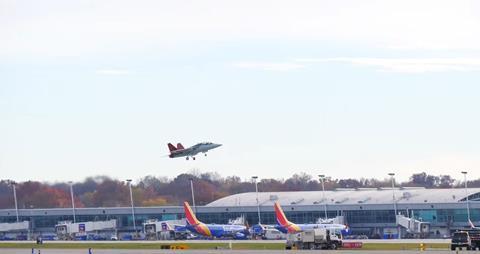
Boeing has previously stated it plans to begin assembling production-model T-7A airframes in the second quarter of 2024. The company’s St Louis assembly plant will be capable of producing 60 Red Hawks annually, according to Boeing’s T-7 programme manager Evelyn Moore.
Multiple delays and serious cost overruns on the development phase of the T-7A have caused the Pentagon to hit Boeing with penalty charges in the billions of dollars, including $900 million in the third quarter of 2024 alone.
Despite those headwinds, the USAF remains bullish on its prospects for the new trainer.
“T-7 is going to revolutionise how we do pilot training and how we do introduction to fighter fundamentals,” Brantigan says. “This aircraft is going to provide much more complex training scenarios for students”.
The T-7A boasts a number of features that promise significant improvements to pilot training over the aged T-38. Its modern avionics offer a cockpit that is more representative of a fifth-generation fighter, while also being able to simulate the latest air combat radars – without the expense of installing such a sensor on each jet.
Each Red Hawk will also be networked with a ground-based flight simulator system, allowing multiple aircraft and simulators to fly cooperatively or against one another in training scenarios.
Boeing has even tested a novel augmented reality system under development by start-up Red 6 that would allow pilots in the air to see imaginary aggressor aircraft visually projected onto their helmet visor for more realistic training on air combat manoeuvres.
See footage from the US Air Force’s T-7A test campaign at Edwards AFB:


